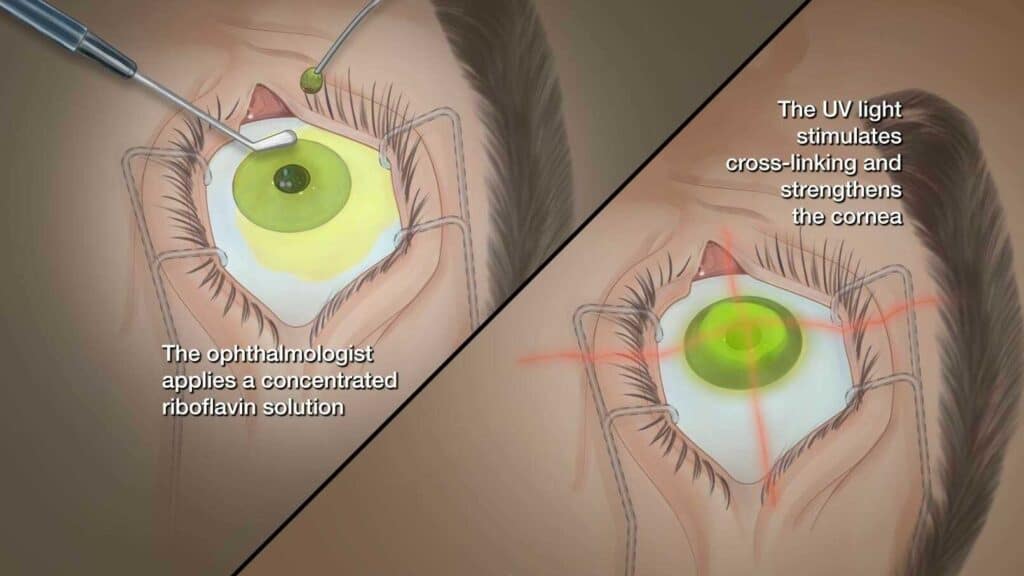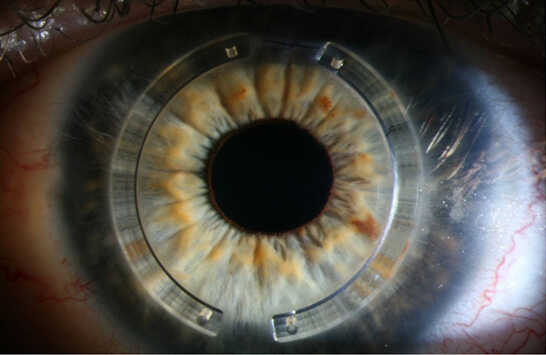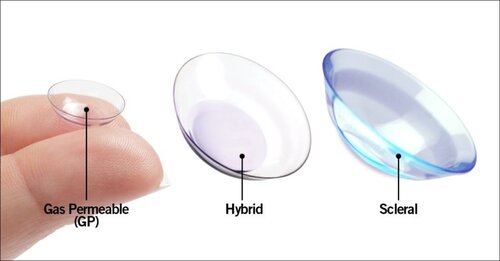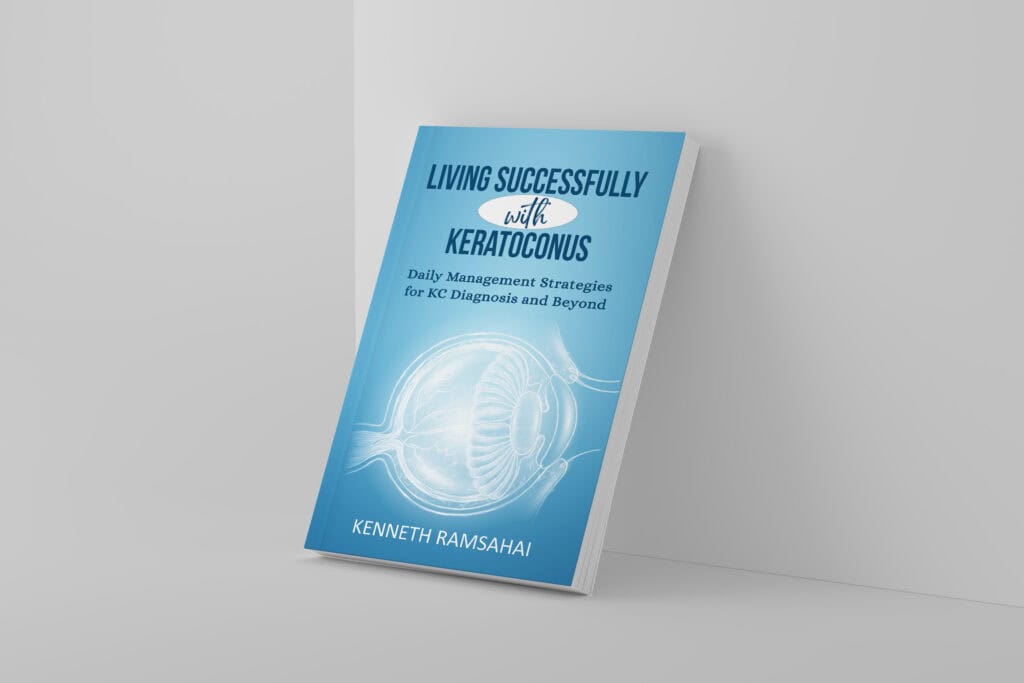When we are first diagnosed with keratoconus we have several options in terms of treatment for keratoconus. The options that will be available to us will depend on what stage of keratoconus we are in. Coupled with how aggressively the disease is progressing.
As an example, I was diagnosed in the advanced stages of keratoconus and the disease was progressing aggressively.
In my case, my options were limited to full right corneal transplant to avoid other complications of keratoconus.
Two Approaches Treatment of Keratoconus
- Slowing or halting the progression of keratoconus.
- Restoring our vision.
Treatment of Keratoconus to Slow Down Progression
Corneal-Collagen-Cross Linking

Corneal collagen crosslinking– This treatment for keratoconus consists of using riboflavin eye drops coupled with ultraviolet light. The treatment of cross linking the cornea stiffens the cornea. This will prevent further shape changes and distortion of our cornea due to keratoconus.
This treatment for keratoconus will reduce the amount of vision loss due to keratoconus. Thus improving our quality of life with keratoconus.
Early Detection is Important
Increasing Our Changes of Success
The best results for corneal-collagen-crosslinking are achieved when it is performed on those of us that are diagnosed in the early or intermediate stages of keratoconus. As an example, when I was diagnosed, cross linking was not yet an option.
However even if it was, I was already in the advanced stages of keratoconus when I was diagnosed therefore I would not have been a good candidate for cross-linking.
Corneal Transplant
Corneal Transplant– This is when a donor donates their cornea and this cornea is used to replace our damaged cornea. Transplants are performed on an outpatient basis and takes about an hour.
I have undergone a corneal transplant myself and it takes 3-6 months to recover from. Medication must be taken to avoid rejection.
For example I still use anti rejection drops once a day and will probably do so for the remainder of my life.
It’s important to note that the corneal transplant does not work to restore vision but rather to prevent further complications of keratoconus such as hydrops.
Keratoconus Vision
As mentioned earlier, treatment for keratoconus is a two pronged approach. Firstly, slowing down or halting the progression of keratoconus and secondly vision restoration. Both approaches work together to increase our quality of life.
Vision Restoration
Corneal Ring

For many of us wearing contact lenses are too uncomfortable. A Corneal-ring is an intact, C-shaped plastic implant that is used to flatten the shape of the cornea improving vision.
They also allow for a better fit of contact lenses. The procedure takes about fifteen minutes.
They also allow for a better fit of contact lenses. The procedure takes about fifteen minutes.
Contacts for Vision Restoration
We Have Several Options

Gas permeable contact lenses– This option is for those of us where glasses or soft lenses are of no help to use anymore
Custom soft contact lenses– These lenses have been specially designed for sufferers of keratoconus. Soft contact lenses are meant to help those of use with mild keratoconu.
The lens can be custom fitted to fit each individual case and have been proven to be more comfortable than gas permeable GP lenses.
They are available in a variety of sizes unlike regular soft lenses. However, as mentioned above, they are best suited for those with mild keratoconus.
Piggybacking contact lenses– Fitting an eye with keratoconus for lenses is challenging and the fit can be uncomfortable.
For this reason some practitioners opt for the piggyback lens approach.This approach consists of a soft lens made of silicone hydrogel.
The lens sits over the eye and then placing a second gas permeable lens on top of the soft lens hence the word piggyback. Literally one lens piggybacks on top of another lens.
Hybrid contact lenses– The hybrid contact lens combines a highly oxygen permeable rigid center with a soft outer skirt. The soft outer skirt rests on the eye to help with comfort. These lenses are specifically designed for keratoconus. This design also vaults over the sensitive cone shaped cornea. They are also available in a large variety of sizes and parameters.
Scleral and semi scleral contact lenses– These are large diameter lenses that completely vault over the cornea and rest on the scleral which is the less sensitive white part of the eye.
Semi scleral covers a smaller portion of the eye, in contrast to the scleral that covers a larger portion of the eye.
Furthermore, since the center of the lens vaults over our irregular shaped cornea and does not apply any pressure to the cornea. We have a higher chance of achieving a comfortable fit.
In addition, the scleral is much more stable than the GP lenses. To put it differently, GP lenses tend to move with every blink of the eye because they cover only a portion of the cornea. In contrast, the Scleral does not move nor do they fall out.
Prosthetic lenses– Those of use with severe keratoconus like I have, need practitioners with special imagery software and advanced expertise to map and fit our eyes for lenses.
These lenses allow for the back of the lens to fit our unique irregularities while the front of the lens remains smooth.
This option might not be available to everyone because of specialized training and software required. These are the lenses that I currently wear. They Changed my life.
Key Takeaways
- The earlier we are able to get diagnosed the earlier we can start treatment for keratoconus to slow down and even halt the disease with treatments like corneal-collagen-crosslinking.
- Vision restoration for many of us can be achieved with the help of our practitioner and lenses with no surgery required.
- We can also restore our vision with surgical procedures such as intacs.
Very Proud To Announce
Want to see what’s inside? Click the book cover, which is also available in audiobook format, to read a free sample on Amazon. Discover how the “Clear Vision Window” concept can transform how you manage life with keratoconus.
If you find the sample valuable, please consider purchasing the complete book. Your purchase supports the keratoconus community while giving you access to all the practical strategies I’ve developed over three decades.
If you do purchase, I’d appreciate an honest review—it helps others with keratoconus find this resource.

To Summarize
Treatment of keratoconus will require stabilizing the disease followed by choosing the best tools and options with the help of our practitioner, for our vision restoration.
Early detection is key. If you or someone in your circle is experiencing decreased vision especially if they are in the adolescent years, please get screened for keratoconus immediately.